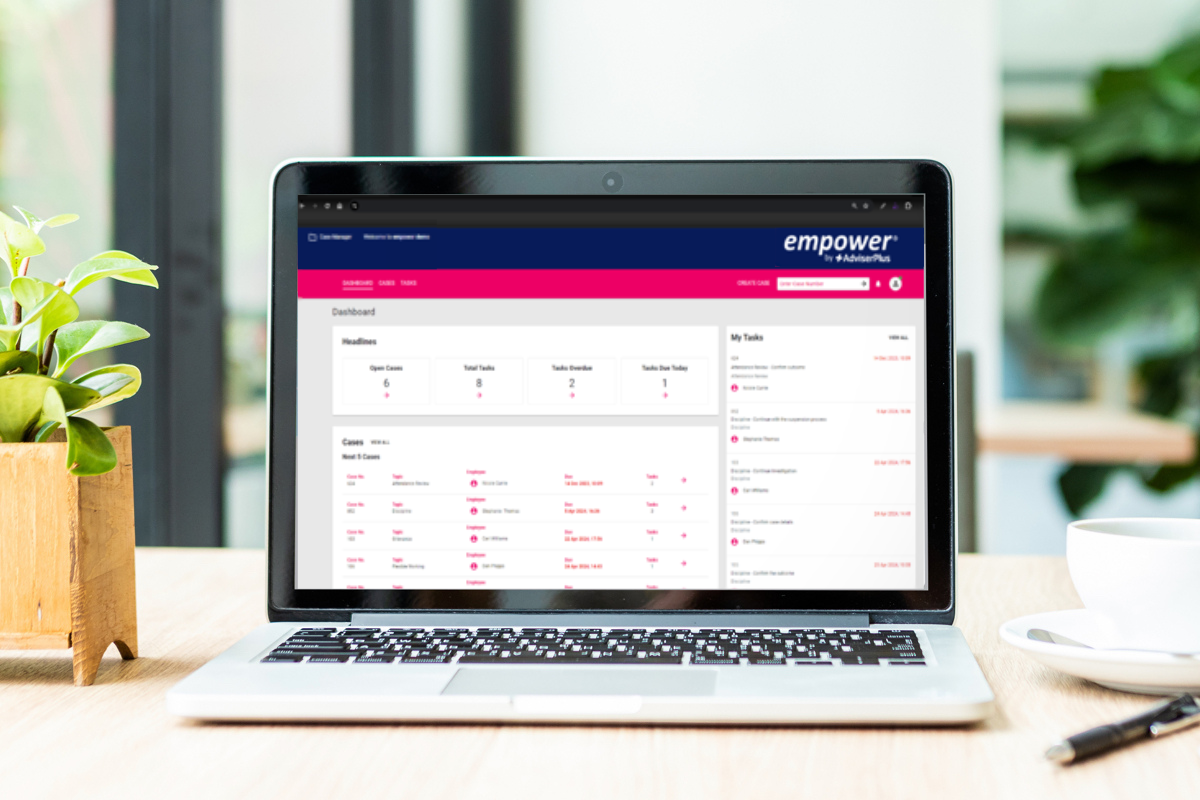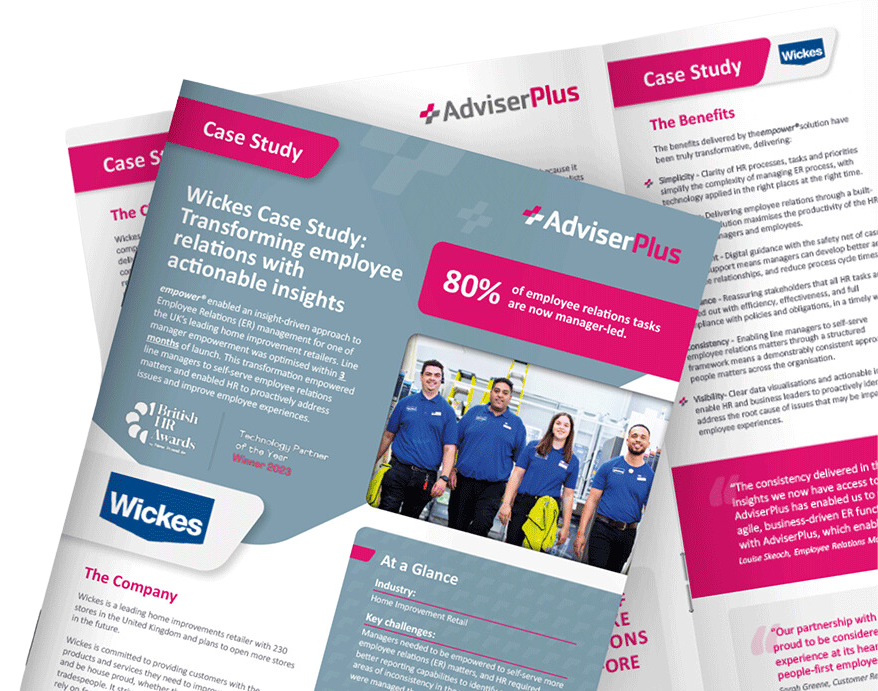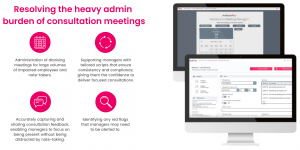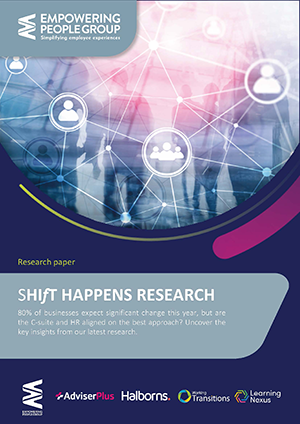Shift happens: Simplifying the changes organisations are grappling with
Why businesses need to simplify change to drive efficiency
Organisations across the UK are navigating significant upheaval in the aftermath of the publication of the Employment Rights Bill and Labour budget announcement. Adapting to this new regulatory and economic reality is putting HR and business leaders alike under additional pressures.
Our latest ‘Shift happens’ findings identified that 4 out of 5 businesses will face large-scale change that will include redundancies in the next 12 months. With the added complexities and pressures from the legislative changes, this figure could well rise. The findings overwhelmingly point to a need to simplify the complexity of managing change to improve employee experiences and deliver better business outcomes.
For HR leaders, managing and preparing for this change requires a structured, simplified approach that reduces the administrative burden on teams so that they have more time to focus on those impacted. In this blog, we explore solutions to help organisations achieve this and simplify the process.
Preparing for legislative and financial change
As we’ve discussed in a previous blog post, the new day one rights to unfair dismissal protection, statutory sick pay, and parental leave eligibility – though set to take effect no earlier than 2026 – are likely to significantly increase administrative burden on organisations.
Organisations must also account for increases to the National Living Wage and employer NI contributions. Given these new legislative and financial challenges, it’s understandable that businesses will need to cut costs.
With such immediate pressure, headcount reductions are often seen as a quick fix to reduce costs which can have an immediate impact on the bottom line. However, this approach may not be the most effective or sustainable in the long term. Instead, investing in transformation strategies that enhance productivity and employee experiences can yield better results.
The real impact of this change
The impact of these changes on resource demands is inevitable. For example, we analysed data to support customers in predicting the impact the new day one rights might have on probation tasks. Just considering this one area alone, we project an increase of up to 230% in probation-related case-activity, which could require 13% more employee relations (ER) advisory resources.
This is a steep increase for already stretched HR teams and will require meaningful changes, including policy reviews and engaging training for managers. All of this must be done while managing legal and operational risks effectively.
Based on this increased complexity and resource requirements, it’s essential to look at alternative ways to improve processes to help drive efficiencies and reduce the impact on people and the bottom line.
Simplifying to thrive: Strategies for HR and cost-efficiency
Managing change effectively requires a balance of strategic foresight and practical action. To ensure compliance, reduce costs and maintain employee engagement during transitions, there are a few things businesses can do:
- Prioritise streamlining processes, such as employee relations case management, to reduce the administrative burden on HR and prevent potentially costly errors.
- Invest in the right technology to empower managers, ensuring consistency, compliance and efficiency while enabling HR teams to focus on strategic priorities.
- Leverage data for proactive decision making and address issues before they become an expensive problem.
- Upskill managers to improve their capability and confidence as people leaders, reducing the need to involve HR in as many employee relations matters and enhancing employee engagement.
Digital transformation, when supported by fit-for-purpose technology, enables organisations to achieve these objectives more effectively. By integrating the right tools, businesses can streamline complex processes, ensure compliance, and empower managers to take a proactive and confident approach to employee relations. This not only reduces costs and administrative burdens but also drives meaningful employee engagement and allows HR teams to focus on delivering strategic value.
The need for efficiency: Free up capacity for HR
Building greater efficiency into your HR strategy is more than just a response to budget pressures – it’s about creating a sustainable HR function that isn’t overwhelmed and that can deliver more value for the organisation at large.
Day-to-day employee relations matters, such as simple grievances and disciplinaries, and sickness absence management, should be able to be managed effectively by line managers. But many line managers haven’t had the training and lack the capability to do this without risk, as detailed in this Employee Relations 2.0 research. So, most employee relations issues are elevated up to HR. This can result in a poor experience for the employee and creates more pressure on HR.
Due to their close relationship managers have with affected employees, it would be a much better experience for all if managers could self-serve these matters without defaulting to HR.
Empowering managers for routine ER tasks
Large enterprises are increasingly turning to technology to streamline time-consuming documentation and manual admin tasks, enabling HR to work more efficiently and focus on strategic priorities, whilst ensuring managers handle people matters in a way that’s compliant with employment law change.
Providing clear ER case management processes that guide managers through consistent, compliant steps enable early intervention and better resolutions. Automating prompts and templated communications aligned with your organisation’s policies and procedures ensure employee matters are handled confidently, competently, and compliantly.
This empowers managers to self-serve more ER cases, improving the experience for all parties involved. As a result, HR can focus on strategic activities that drive long-term business success, such as enhancing employee engagement, well-being, and retention.
Introducing a dedicated employee relations case management system
empower® by AdviserPlus is a market-leading employee relations case management system that guides managers through employee relations cases such as grievances and disciplinaries, reducing the need for HR involvement in every instance. HR is only brought in on complex cases, ensuring their expertise is focused where it’s most needed.
Using valuable people metrics – like sickness absence rates, grievance and disciplinary patterns, and case resolution times – empower® delivers accessible dashboards that identify trends and insights within large data sets. This can help with internal benchmarking, such as comparing employee relations cases across departments, to proactively address emerging issues.
Wickes: Improving employee relations and reducing costs
Wickes achieved a 50% reduction in employment tribunal claims and associated costs, using empower® as their dedicated ER case management system. They’ve significantly increased the amount of employee relations tasks that are manager led to a point where 80% are self-served by managers, and they’ve improved the visibility of ER cases for both managers and HR, delivering more consistent, compliant processes, and positive employee experiences.
Other tech-led services that transform ways of working and engagement
We don’t just transform employee relations management. We are also experts in supporting change and upskilling your workforce.
Transforming large-scale consultation processes
With more than 80% of UK organisations expected to undergo significant change in the next 12 months, including redundancies, HR teams face the challenge of ensuring these processes are both compliant and compassionate.
When overwhelmed with administrative tasks like scheduling meetings and tracking progress, it becomes harder to provide a positive, lasting impact on both affected employees and those remaining in the business.
Meeting Manager from AdviserPlus transforms one-to-one consultation meetings, making them more efficient and compliant by streamlining the process of diarising meetings, supporting with tailored scripts, and automatically capturing and sharing consultation data to provide valuable insights.
As a result, managers can deliver consultations that not only minimise business risk but also ensure a more compassionate approach, keeping the focus on what matters most – your people.
Transformational manager training
Providing the right support with technology is only part of the solution. As mentioned previously, many managers have never received formal training to be effective people leaders. Providing this training can mean the difference between an unengaged workforce with high attrition rates and engaged employees who feel supported and enthusiastic in their roles.
As part of the Empowering People Group, we’re able to lean on a wealth of additional expertise.
For organisations who require a robust digital learning and development programme for their managers, Learning Nexus’ curated courses provide the ideal solution. Building managers’ confidence and competence can transform their ability to inspire, drive results and unlock employees’ full potential for long-term business success. You can find out more about the course collection here.
In addition to digital management training options, leadership coaching materials from our partners at Working Transitions guide managers in building their leadership capabilities, strengthening their ability to lead teams and manage people with confidence. Together, the training and coaching create a comprehensive support system, ensuring that managers have all the tools they need to succeed. Find out more here.
The time for change is now
Simplifying workplace transitions improves business and people outcomes, particularly when supported by tailored training and user-friendly tools that empower managers to adapt confidently. With the right frameworks in place, HR leaders can create a smoother path to compliance while maintaining focus on their broader people strategy.
Although the seismic legislative changes in the Employment Rights Bill won’t be coming into effect until 2026, it would be prudent to take proactive steps now rather than waiting until it’s a legal necessity. Adopting the right tools and frameworks will only improve operational efficiency, improve employee engagement, and deliver measurable cost savings.
By taking these steps, businesses can navigate change with confidence and position themselves for long-term success.
Download our Shift happens research
Our latest HR research paper ‘Shift happens: Simplifying business change for better business and people outcomes’ delves into the complexities of large-scale change. We surveyed 250 large organisations to understand their challenges and the importance of managing change compliantly and compassionately.



